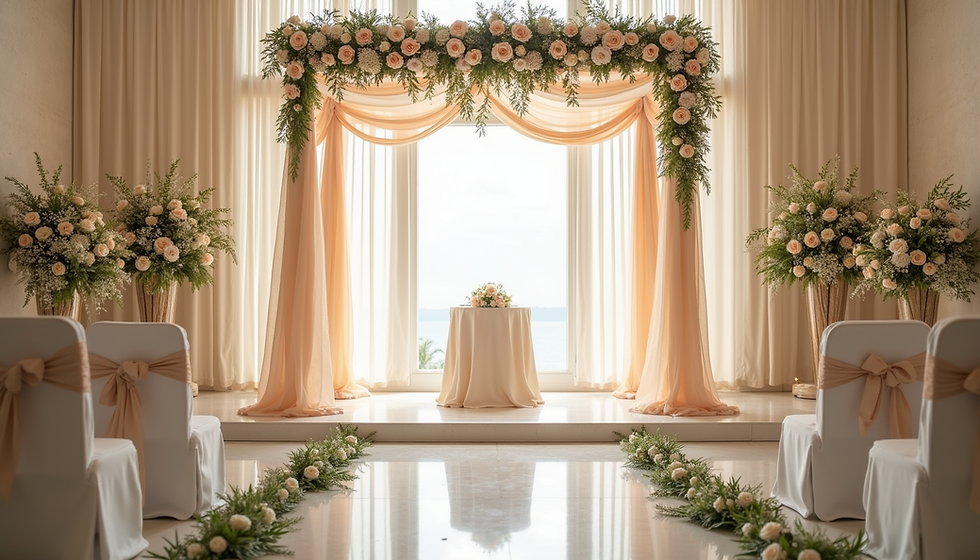The Importance of Symbolic Gestures in Life Ceremonies
- ben07243
- Oct 23
- 4 min read
Updated: Nov 3
Symbolic gestures have been a crucial part of human culture for centuries. They serve as powerful tools to express emotions, beliefs, and traditions. Whether during weddings, graduations, or important life events, these gestures enrich ceremonies and deepen connections among participants.
In this post, I will explore the importance of symbolic gestures throughout history, examine various gestures from different cultures around the world, and highlight unique gestures found in Scottish tradition.
The Importance of Symbolic Gestures Through History
Symbolic gestures have shaped human history. They often bridge the gap between physical actions and spiritual meanings. From ancient rituals to contemporary ceremonies, these gestures mark significant transitions, honouring traditions and celebrating milestones.
For example, lighting a candle is more than just an act; it symbolises hope and remembrance, serving as a reminder of loved ones lost. Similarly, the exchange of wedding rings signifies commitment and unity, representing a lifelong bond. In fact, studies show that couples who incorporate meaningful gestures into their ceremonies report higher satisfaction in their relationships.
These gestures reflect the values of the societies in which they are practiced, acting as communal affirmations of shared heritage and identity. In this sense, they not only convey personal meaning but also contribute to a collective cultural narrative.
Symbolic Gestures Around the World
Every culture has developed unique symbolic gestures that carry significant meanings. Here are a few notable examples:
The Japanese Tea Ceremony: More than just a drink, this ceremony embodies harmony, respect, purity, and tranquillity. Each movement is intentional, showcasing the beauty of simplicity and mindfulness, which resonates with participants and encourages deeper connections.
The African Maasai Jumping Dance: Young warriors perform this dance to show strength and attract mates. It symbolises bravery and signifies the transition from adolescence to adulthood, with young men often jumping higher than their peers as a rite of passage.
The Indian Saptapadi: In Hindu weddings, the couple takes seven steps together. Each step represents a vow, such as health, wealth, and companionship, highlighting their commitment to a shared life. This act sets a strong foundation for their future together.
The Native American Smudging Ceremony: Burning sacred herbs during this ritual symbolises purification and protection, as the smoke is believed to carry healing prayers to the spirit world. It is often performed during important events, creating a sacred and cleansed atmosphere.
These gestures contribute not only to the richness of the ceremonies but also to a sense of belonging and continuity within communities. They often serve as rituals that families may pass down through generations.
Scottish Symbolic Gestures and Their History
Scotland boasts a rich tapestry of cultural traditions filled with symbolic gestures that reflect its history and values. Here are some examples:
The Quaich: This traditional Scottish cup is used in ceremonies to symbolise friendship and trust. During weddings, the couple drinks from the Quaich, which represents their bond and commitment to one another. This can enhance feelings of unity and shared purpose.
Handfasting: An ancient custom, handfasting binds the couple's hands together with a ribbon, symbolising their union. This gesture represents their commitment to each other, reinforcing the idea of partnership and shared life goals.
The Clans' Salute: Clan members often perform a salute, raising a sword or hand in greeting. This gesture symbolises loyalty and unity, reminding individuals of their shared identity and heritage amid diverse backgrounds.
The Piper's Welcome: The sound of bagpipes is integral to Scottish culture. Having a piper play at a ceremony, whether a wedding or funeral, signifies honour and respect, linking the present with the cherished traditions of the past.
These gestures celebrate individual milestones while also serving as reminders of Scotland's rich cultural heritage, fostering pride and a sense of belonging among its people.

The Emotional Impact of Symbolic Gestures
The emotional power of symbolic gestures is significant. They evoke feelings of nostalgia, joy, and connection, allowing participants to engage with the ceremony deeply.
During a wedding, exchanging rings is not just a formality. It is a moment of love and commitment, representing the promise of a shared future. Likewise, lighting candles at memorial services provides a space for reflection and remembrance, creating an atmosphere that encourages healing.
These gestures foster community spirit. When people gather to perform a symbolic action, they create bonds that transcend individual differences, highlighting the importance of unity and shared purpose. A study from the Journal of Social Psychology indicates that participating in rituals enhances group cohesion, reinforcing community ties.
Incorporating Symbolic Gestures in Your Ceremony
As you plan your next ceremony, consider incorporating a symbolic gesture that resonates with your values and those of your community. Not only will it enrich the experience, but it will also create lasting memories that you and your loved ones will treasure for years to come.
The Role of Personalization
Personalization is key to making a ceremony unique. Think about gestures that reflect your story and beliefs. This could be a family tradition or a new idea that holds special meaning for you.
For instance, you might choose to include a symbolic gesture that represents your journey together. This could be planting a tree, which signifies growth and strength, or creating a memory box filled with items that represent your relationship.
Conclusion
Symbolic gestures are powerful expressions of culture, emotion, and identity. They shape human experiences from ancient times through modern ceremonies and continue to play vital roles in our lives.
By understanding the significance of these gestures, we can appreciate the rich traditions that connect us to our heritage and each other. Whether it is a Quaich in Scotland or a tea ceremony in Japan, these gestures remind us of the beauty of human connection and the importance of celebrating life's milestones together.






Comments